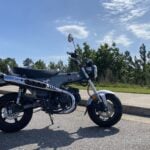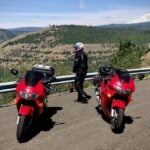Arizona joins a growing list of states adopting the practice
Arizona has approved a bill that will allow the practice of lane filtering in stopped traffic across the state. The law goes into effect at the end of their 2022 legislative session, meaning September. The practice, which essentially means motorcyclists passing in between vehicles and lanes when traffic is at a standstill, was signed into Arizona law a few days ago, and gives riders the option to pass around automobiles stopped in the same lane. Utah has been experimenting with a similar initiative since 2018, and has since extended their research another five years to fully gather data on the safety success of lane filtering in their state.
Arizona’s practice includes the following stipulations:
*The posted speed limit does not exceed 45 miles per hour.
*The motorcycle is not going faster than 15 miles per hour.
*The street is divided into at least 2 lanes with the same direction of travel.
Supporters make the case that lane filtering helps motorcyclists avoid being sandwiched between automobiles or getting rear-ended in the event of an impending accident. With traffic increasing in many cities, and the increased distractedness of motorists (why so many states now have laws against cell phone use while driving), advocacy groups like ABATE, the AMA and others have encouraged legislation across the country that would make lane filtering possible and more widely accepted.
“ABATE of Arizona put up a strong showing to successfully get this law signed,” noted American Motorcycles Association (AMA) Western States Representative Nicholas Haris. “It is a welcome sight to see more states adopting commonsense safety laws that protect motorcyclists when they are most vulnerable to a collision. The AMA is committed to working with riders nationwide on efforts to pass similar legislation and educating the public about its benefits.” Arizona now joins Utah and Montana as the latest states to legislate lane filtering in some form. We understand a bill is now before the Oklahoma House and Senate for consideration as well.
California was the first state to institute the practice lane filtering years ago, and it has changed the culture of road travel across the state, as well as saved countless motorcyclist’s lives. We experienced Cali lane filtering a few years ago coming back from a ride up through Baja. Entering the San Diego area, then riding back into L.A., we used lane filtering to navigate stop/go traffic, and were surprised to see cars ease over to one side of their lane or another to let us riders slip through. We took it easy, riding slow and carefully, and the respect and deference we were shown by SoCal motorists was welcome and refreshing. I mused, “This really works, once you condition a state’s drivers to respect the practice. We need this in more states.”
I’ve been to the Far East as well, specifically Japan and Indonesia, and I’ve seen the widespread lane filtering practiced by the vast number of motorcycle and scooter riders in that part of the world. As chaotic as it can look to our uninitiated Western eyes, witnessing so many bikes moving and snaking between cars, trucks and busses, it works. I’ve seen amazingly few rider crashes and injuries in my travels there, and noted how the practice is not only accepted, it’s actually expected.
Lane Filtering in Jakarta, Indonesia, back when I was there in 2016. Works for them. Photo by my friend Shayne Russell.
The AMA has supported “lane splitting” for some years now, basing their stance on the success of it in California and a U.C. Berkely study that concluded the practice really did make a difference in rider safety out on the streets. “A motorcycle’s narrow width can allow it to pass between lanes of stopped or slow-moving cars on roadways where the lanes are wide enough to offer an adequate gap,” the Berkley study stated. “This option can provide an escape route for motorcyclists who would otherwise be trapped or struck from behind. There is evidence (Hurt, 1981) that traveling between lanes of stopped or slow-moving cars (i.e., lane splitting) on multiple-lane roads (such as interstate highways) slightly reduces crash frequency compared with staying within the lane and moving with other traffic.”
By the way, the AMA defines lane splitting as “the practice of riding a motorcycle between clearly marked lanes for traffic traveling in the same direction” whereas they define lane filtering as “the practice of riding a motorcycle between stopped motor vehicles to the front of the pack, typically at a signalized intersection.” There is a difference.
This works. Let’s make it happen. Photo by AMA.
We’ve all found ourselves in dense, congested traffic before, surrounded by “cagers” on their phones, fiddling with their array of automotive dashboard options, or doing some other activity besides focusing forward (eating, brushing their hair, doing makeup in the mirror, etc.). How many times have you wished you could just remove yourself from the situation (especially on roasting hot days) and skirt around or through? With lane filtering gaining traction across the country like it already has in so many nations around the world, here’s hoping that we’ll be legally able to, more frequently and in more locales around the country, in the not-too-distant future.
What’s your thoughts on lane filtering and/or splitting? Share in the comments below!
For more on the AMA’s position and research on lane splitting or filtering, click here:
*Info sourced from the AMA, WebBikeWorld, and Fox 10 Phoenix.



























Yes, because let the motorcyclists decide if they want to lane split or not.
Agreed.
Yes please. Some of us already do it but we encounter rude people that I think we’re cheating, or beating them to the punch or something.
I think the states that implement it should also make an effort to educate their general population about it as well, like California has done, so people understand its benefits to riders and non-riders alike.
yes. sometimes a car will move over to the lane divider to impede your progress.
Legalize it everywhere.
I believe it’s about time for lane filtering I’ve been rear-ended and side swiped while in heavy traffic … I practice it even though it’s not legal I’ll take the ticket until this becomes legal in Oregon
It is absolutely safer. Not only is it better for the motorcycle for sure.
Makes a lot of sense. Hopefully they pass a law in Alberta
Ca allows traffic splitting. the biggest cause of accidents is caused by tailgaters.
i split when needed. i have a few friends that will not split.
coming up the 14 (blood alley) i frequently split the morning and evening rush. years ago a young cyclist would split at 60-70 mph which is dangerous. 3 months later he was on the median covered by the chp. ya gotta do it in a safe manner. experience is key.
Growing up in Southern California this was always just normal. I learned to ride this way. Moved out of state, and I had to basically relearn how to ride in traffic.
So yeah, I am all for it.